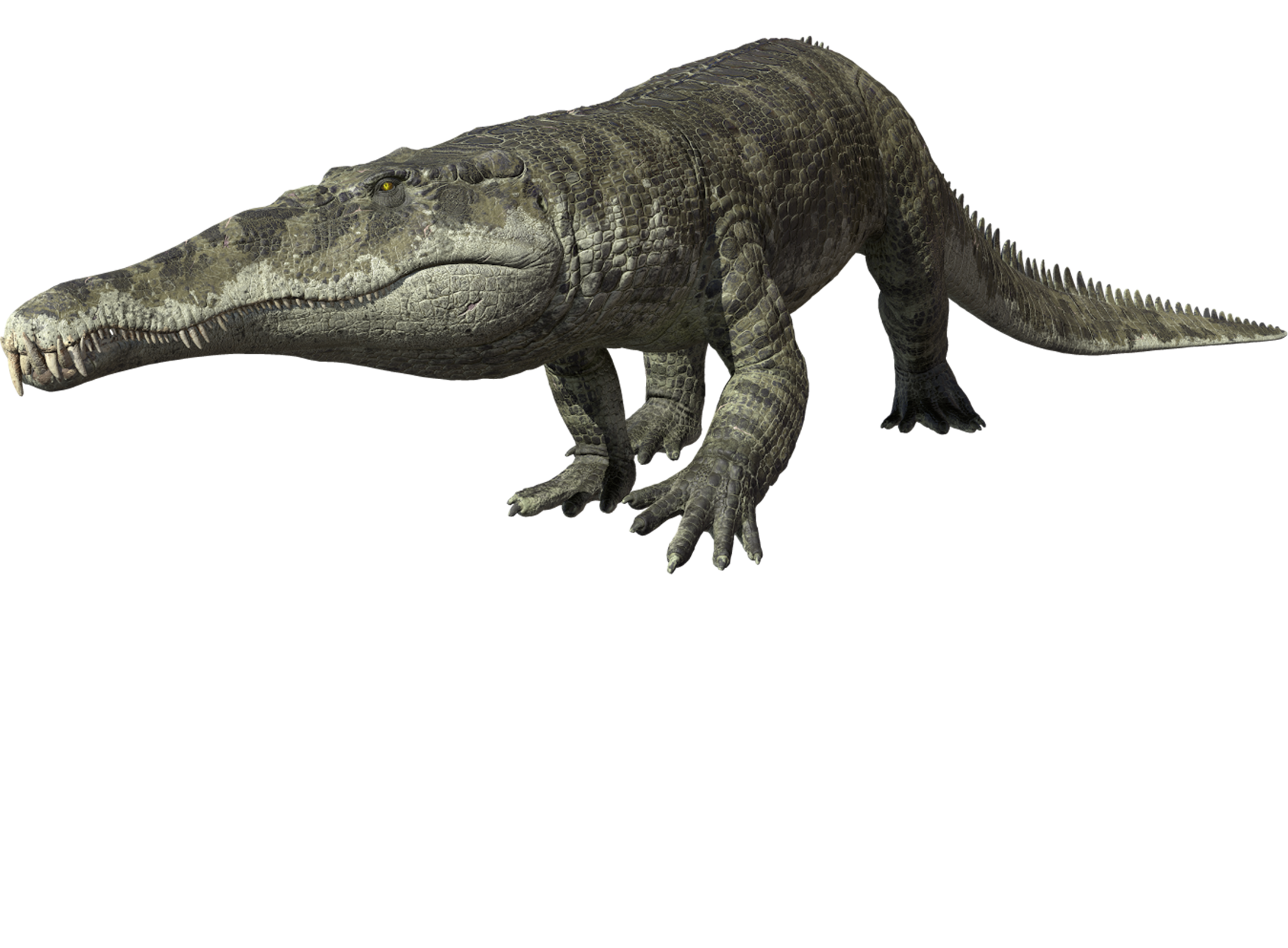The Super-Croc Before Crocs
The Late Triassic wetlands were the domain of the crocodile-like phytosaurs, and the largest, Smilosuchus, ruled what is now Arizona and was the Triassic equivalent to the Cretaceous "super-croc" Sarcosuchus!
Overview: The waterways of the Triassic weren’t dominated by crocodilians as they are today. Instead, they were ruled over by the phytosaurs, a group which superficially resembled crocodiles, but which were only distantly related. Among the largest of these was Smilosuchus which ruled the rivers and lakes of the American Southwest for much of the Late Triassic. Possibly exceeding 30 ft in length, these were the original “super-crocs”. Despite not actually being crocs, they nevertheless foreshadowed true super-crocs like Sarcosuchus, Deinosuchus, and Purussaurus, which would evolve later in the Mesozoic and Cenozoic.
Discovery: Smilosuchus was discovered in the Late Triassic Chinle Formation of Arizona. It was first named in 1930 by Charles Camp as Machaeroprosopus gregorii. Later it was considered a species of the closely related Leptosuchus. However, in 1995, Robert Long and Phillip Murray moved the species into its own genus, Smilosuchus, meaning “chisel crocodile”.
Evolution and Description: Smilosuchus was a type of phytosaur, a group of outwardly crocodile-like reptiles which dominated Middle and Late Triassic freshwater ecosystems. Phytosaurs were reptiles which were members of Archosauromorpha, Archosauriformes, and Crurotarsi, but which fell right outside of true Archosauria. Thus, they were indeed relatives of crocodiles, but only distantly, and technically equally related to both crocodiles and dinosaurs. They first appeared in the Ladinian stage of the Late Triassic, replacing the previous group of archosauriform croc-look-alikes, the proterosuchids, which had gone extinct a few million years previous. Smilosuchus was a derived Phytosaur in the family Parasuchidae, and first appeared about 221.5 million years ago in the Norian stage of the Late Triassic.
Phytosaurs outwardly resembled crocodilians, with short semi-sprawled legs, a long and powerful tail, a flattened head with a long snout, generally conical teeth, and protective osteoderms covering its back. However, there were also ways that these animals differed from true crocodilians. Perhaps most notably, while crocodilians have nostrils at the end of their snouts, phytosaurs like Smilosuchus had their nostrils on top of their heads near their eyes, similar to the nostril position in modern whales. Additionally, while the snouts of crocodilians are made up of the premaxilla, maxilla, and nasal bones, the snouts of phytosaurs consisted of only the extremely elongated premaxilla. What’s more, the teeth of phytosaurs, while conical, were serrated like a dinosaur’s and unlike a modern crocodilian’s. Phytosaurs also lacked a hard boney secondary palate, which is what allows a crocodilian to breath through its nose when its mouth is submerged, though they likely had a soft tissue palate that served the same function.
Smilosuchus was one of the largest known phytosaurs, with a skull 1.55 m (5.09 ft) in length, and a total body length of at least 7 m (23 ft), but possibly as long as 12 m (39), and possibly weighing in the ballpark of 1.5-5 tonnes (1.65-5.1 US tons) based on the mass of the extant saltwater crocodile, which approximates the minimum size for Smilosuchus, and the extinct “super-croc” Sarcosuchus, which was slightly smaller than the maximum estimates for Smilosuchus! Its huge size makes Smilosuchus one of the earliest “super-crocs”, despite not being a true crocodylomorph. Unlike most crocodilians and some other phytosaurs, Smilosuchus had heterodont dentition, or different types of teeth for different tasks. In the front of its mouth, it had large tusk-like teeth for impaling prey, and toward the back of the mouth, its teeth became more blade-like for slicing flesh.
Ecology: Smilosuchus lived in the Late Triassic of the Chinle Formation in what is now the American Southwest. In the Late Triassic, the region, and indeed much of the world’s land, which was all in one supercontinent called Pangea, was arid and seasonal. The Chinle nevertheless had an abundance of lakes and river systems which would have been the domain of Smilosuchus. Most phytosaurs probably ate fish, but those like Smilosuchus, which had more robust skulls and heterodont dentition likely also consumed many terrestrial animals as prey, which they would have caught by aquatic ambush, as do many large modern crocodilians like Nile and saltwater crocodiles. Smilosuchus’s tusk-like front teeth would have helped it grab large prey, and its more blade-like back teeth would have helped in processing its food. Prey of Smilosuchus may have included the coelacanth Chinlea, the lungfish Ceratodus and Arganodus, the herbivorous archosauromorph Trilophosaurus, the early theropod dinosaur Coelophysis, and the large dicynodont therapsid Placerias. Smilosuchus shared its environment with other phytosaurs including Machaeroprosopus, Leptosuchus, and Redondasaurus.
Extinction and Legacy: Smilosuchus went extinct at the end of the Norian Age of the Triassic Period about 205.6 million years ago. This was a time of great change, as much of the climate was becoming increasingly arid, and many animal groups that had been common in the Triassic were in decline. Phytosaurs as a whole would survive until the end of the Triassic, 201.4 million years ago. In the American Southwest, Smilosuchus was survived by the closely related phytosaur Redondasuchus. After the extinction of the phytosaurs, true crocodylomorphs took up the role of croc-like semi-aquatic predators, a role they still hold to this day. Today, Smilosuchus can be found in museums such as the Rainbow Forest Museum in Petrified Forest National Park, near Holbrook, Arizona, USA, the Smithsonian Museum of Natural History in Washington DC, USA, and the American Museum of Natural History in New York City, New York, USA. While Smilosuchus has not featured in any major television or movies (it should!), phytosaurs, such as the similar Rutidon, have been featured in some media, perhaps most notably the 2001 Discovery Channel Documentary When Dinosaurs Roamed America.
Smilosuchus FAQ
Smilosuchus size / How big was Smilosuchus?
See weight and length.
Smilosuchus weight / How much did Smilosuchus weigh?
Smilosuchus probably weighed in the ballpark of 1.5-5 tonnes (1.65-5.1 US tons) based on the mass of the extant saltwater crocodile and the extinct “super-croc” Sarcosuchus!
How long was Smilosuchus?
Smilosuchus was somewhere between 7-12 m (23-39 ft) long.
What did Smilosuchus eat?
Smilosuchus was an apex river predator, possibly consuming large fish like Chinlea, early dinosaurs such as Coelophysis, and other animals, like the large dicynodont Placerias!
What is Smilosuchus’s closest living relative?
Despite rocking a prototype crocodile body-plan, Smilosuchus and other phytosaurs belonged to an older lineage related to archosaurs (dinosaurs, crocodilians, pterosaurs, and their relatives) generally. Thus, the closest living relatives of Smilosuchus are crocodilians and birds.
Smilosuchus family members / Smilosuchus family / What kind of animal was Smilosuchus?
Smilosuchus was a phytosaur in the family Parasuchidae. Phytosaurs were members of the clade Crurotarsi which also includes the archosaurs, which makes them distant relatives of crocodilians and dinosaurs. Phytosaurs looked similar to crocodilians and had similar ecology, but were only distantly related.
Where did Smilosuchus live? / Where was Smilosuchus found?
Smilosuchus lived in the waterways of an arid seasonal environment in what is now the southwestern United States, and its remains have been found in Arizona.
When did Smilosuchus live?
Smilosuchus lived about 221.5-205.6 million years ago during the Late Triassic Period.
What does Smilosuchus mean? / Smilosuchus name meaning
Smilosuchus means “chisel crocodile”.

